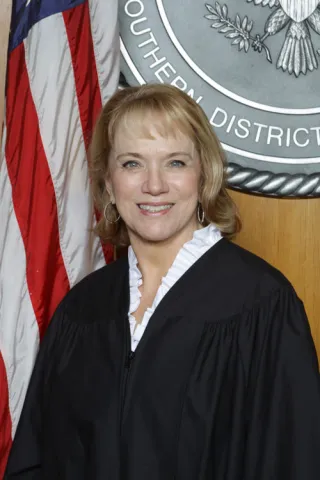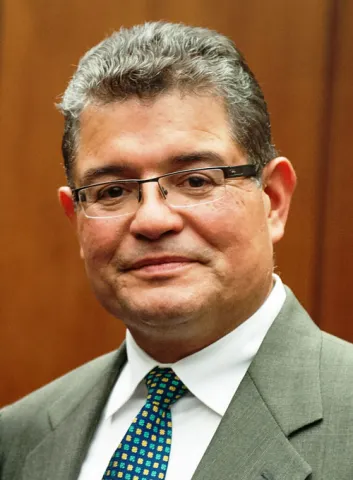
Chief Judge Cecelia Morris, Southern District of New York Bankruptcy Court
The government is running again, but federal district and bankruptcy courts and those who practice in them were shaken, to varying degrees, by the government’s 17-day shutdown at the start of the new fiscal year.
In Southern District of New York Bankruptcy Court, whose caseload includes many high-profile corporate cases, the most time-sensitive matters went forward, but many cases were postponed a month. “Some of our calendars are 200 pages thick. Getting cases back on the calendar will almost be unmanageable,” said Chief Judge Cecelia Morris. “It’s like the proverbial car accident. The first one was just a fender bender, but now cars are backed up 10 miles down the road.”
That assessment was echoed by West Allen, chair of the Government Relations Committee of the Federal Bar Association. While most lawyers adjusted to case reschedulings, “the general impression was that federal courts were on their last breath,” Allen said. “The judges and court staff did an exceptional job of getting through this, but if it had gone even another week or two, there would have been real problems.”
Impacts included delays in bankruptcy and Social Security cases, condensed criminal calendars, cuts in building maintenance, and uncertainty over juror payments. Judges in numerous courts also said they faced weeks of stress and confusion in planning for the possibility, never quite realized, that the Judiciary would spend its last dollar in reserve funding.
While no comprehensive total of cases delayed is available, these are examples of how dozens of federal courts were affected.
Like every other federal court, the Northern District of Illinois had announced plans to remain open, even if Congress declared a shutdown. But as the October 1 deadline passed, judges began receiving motions to postpone cases from furloughed Justice Department attorneys. Chief Judge Ruben Castillo was asked whether the requested delays should be granted or rejected.
On October 7, Castillo issued an order declaring that “all civil litigation involving as a party the United States of America, its agencies, its officers or employees … is immediately suspended, postponed and held in abeyance” for 14 days. Castillo, who said a uniform delay “was the most orderly approach,” said that more than 1,000 cases were temporarily halted.

Chief Judge Ruben Castillo, Northern District of Illinois
Compared with other parts of the federal government, the Judiciary had one significant advantage, during the 17-day shutdown fight. A reserve fund of court filing fees—primarily from bankruptcy cases—was on hand to pay court employees through October 18. When the shutdown ended on October 17, Judiciary employees avoided furloughs—barely.
But it was far from business as usual. Security officers, employed by the U.S. Marshals Service, worked without pay, after the Justice Department declared them “essential” to courthouse safety. Maintenance was cut by the General Services Administration, which provided only skeletal staff to answer inquiries by court managers. And in many courts, extensive furloughs of federal government lawyers caused broad trickle-down effects in the courtroom.
In the three courthouses in the Eastern District of Washington, criminal case calendars were held just three days a week, to accommodate furloughs of criminal prosecutors in the U.S. Attorney’s Office.
An even greater effect was felt on civil lawsuits. Nationwide, about one-sixth of all federal court lawsuits list the U.S. government as either a plaintiff or a defendant. The Southern District of New York (Manhattan) suspended 760 Justice Department cases, while the Northern District of Texas suspended 170 cases. The Eastern District of Kentucky and the District of New Mexico also issued court-wide bans on civil cases involving federal agencies.
Other districts, including the District of Colorado, the Southern District of Iowa, and the Southern District of Illinois, canceled cases on an individual basis, as needed. The District of Arizona received 120 motions for delay, mostly from Justice Department attorneys.
Judge Robert Pratt, who served as the chief judge in the Southern District of Iowa for six years before taking senior status last year, was sufficiently disturbed by the cancellation of some federal cases that he wrote an op-ed in the Des Moines Register, decrying the delays to federal justice.
In one stalled case, a property owner was potentially delayed from selling his house, because the IRS wasn’t available to litigate a tax claim.
“The cases we hear may not seem very important, unless you happen to be one of the people whose case got put on hold,” Pratt said. “This is no small matter for the owner of land who could not sell, mortgage or otherwise exercise ownership rights over property until the shutdown was addressed.”
Some high-profile litigation went forward despite the Justice Department furloughs.
In the Northern District of Texas, a Securities and Exchange Commission case against Mark Cuban, billionaire owner of the Dallas Mavericks basketball team, continued because the SEC had non-appropriated funds available to pay its legal team. And in the District Court for the District of Columbia, the Justice Department was not allowed to postpone a case involving the proposed merger of US Airways and American Airlines. The attorneys worked without pay during the shutdown.
Tensions especially grew in the final days of the shutdown, as the court’s funding reserve was nearly drained, meaning that even money for juror payments would soon become unavailable.
In the Central District of Illinois, Chief Judge James Shadid postponed two civil trials starting the week of October 21, knowing that there might not be money to pay jurors.
Shadid also ordered the court to delay about three dozen cases involving Social Security appeals. “Fairness and common sense dictated that any deadlines should be stayed until everyone was back to work,” he said. “It really was that simple.”
In Chicago, Chief Judge Castillo considered even broader trial cancellations. In the final day before Congress ended the shutdown, he spoke his mind to a local meeting of lawyers who practice in federal courts.
“I told them that if this went on even another day, we’d be shutting down all jury trials,” Castillo recalled. “Asking jurors to serve with the promise of future payment is unfair, when some have to drive 150 miles every day. It’s a big hardship.”
A survey of District of New Mexico judges showed the wide range of cases affected. While no trials were postponed, discovery and other preparatory meetings were canceled in cases involving Social Security, the Equal Employment Opportunity Commission, the National Labor Relations Board, the IRS, and wrongful-death and medical-malpractice suits filed against the Public Health Service.
The nation’s bankruptcy courts also were heavily affected by Executive Branch furloughs. The Justice Department’s U.S. Trustee Office, which monitors bankruptcy proceedings to make sure the system isn’t being abused, operated on skeletal crews. Likewise, U.S. Attorneys representing the IRS, who participate in numerous cases where tax payments are delinquent, also were not available for cases and out-of-courtroom negotiations.
David S. Kennedy, chief judge of the Western District of Tennessee Bankruptcy Court, said the end of the shutdown was fortunately timed, just before courts had to operate without funding. “If it had lasted much longer, the problems would have been devastating.”
While delays in his court were relatively minor, Kennedy expressed concern about the very notion of shutting down court operations. “It flies in the face of our judicial mission in the bankruptcy courts, which is to secure the just, speedy and inexpensive determination of every case and proceeding.”
Pamela Pepper, chief judge of the Eastern District of Wisconsin Bankruptcy Court, said one of the biggest costs was the time spent on endless game-planning to anticipate different shutdown scenarios, and to guide court staff through a stressful, anxious time.
“The biggest impact was the amount of time spent by judges and court personnel figuring out what to do,” Pepper said. “You had court staff wondering if they will be able to pay the mortgage or the rent, judges trying to figure out who we’d send home. It was hours and hours of time that we could have devoted to actually doing our work.”
Subscribe to News Updates
Subscribe to be notified when the news section is updated.
